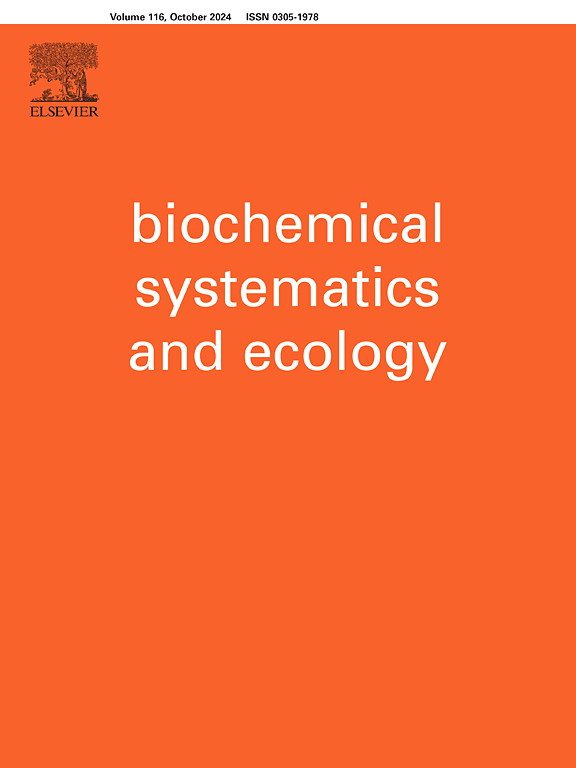IF 1.4
4区 生物学
Q4 BIOCHEMISTRY & MOLECULAR BIOLOGY
引用次数: 0
摘要
花蜜被认为是植物提供给生物的奖励,这些生物可以起到保护作用。这些物质是营养丰富的水溶液,可加强可能的互惠关系。由于植物的新陈代谢因评价时段(白天或夜晚)而异,因此花蜜的成分也应有所不同,这可能会导致不同的动植物关系。在这种情况下,本研究旨在评估在早晨和傍晚采集的植物 Cleome gynandra L. 花蜜的化学成分。化学成分概况是通过 1H 核磁共振光谱测定的。结果表明,花蜜中主要是碳水化合物,其次是氨基酸和有机酸。研究结果还确定了昼夜间碳水化合物特性的变化模式,表明这种变化可能与植物和昆虫之间的关系有关。本文章由计算机程序翻译,如有差异,请以英文原文为准。

Metabolomic study of daytime and nighttime extrafloral nectars of Cleome gynandra L. via 1H NMR combined with chemometrics
Extrafloral nectars are considered rewards the plant offers to organisms that can act as protectors. These substances are nutritious aqueous solutions, which reinforces a possible mutualistic relationship. Since the plant metabolism differs according to the period evaluated (day or night), the composition of the nectars should also be distinct, which may result in different plant-animal relationships. In this context, the present study aimed to evaluate the chemical composition of the extrafloral nectars of the plant Cleome gynandra L., collected in the morning and evening periods. The chemical profiles were determined via 1H Nuclear Magnetic Resonance spectroscopy. The results indicated the majority presence of carbohydrates, followed by amino acids and organic acids. The results also allowed the identification of a pattern of change in the identity of the carbohydrates offered during the day and night, suggesting that this change may be relevant to the relationship between plants and insects.
求助全文
通过发布文献求助,成功后即可免费获取论文全文。
去求助
来源期刊

Biochemical Systematics and Ecology
生物-进化生物学
CiteScore
3.00
自引率
12.50%
发文量
147
审稿时长
43 days
期刊介绍:
Biochemical Systematics and Ecology is devoted to the publication of original papers and reviews, both submitted and invited, in two subject areas: I) the application of biochemistry to problems relating to systematic biology of organisms (biochemical systematics); II) the role of biochemistry in interactions between organisms or between an organism and its environment (biochemical ecology).
In the Biochemical Systematics subject area, comparative studies of the distribution of (secondary) metabolites within a wider taxon (e.g. genus or family) are welcome. Comparative studies, encompassing multiple accessions of each of the taxa within their distribution are particularly encouraged. Welcome are also studies combining classical chemosystematic studies (such as comparative HPLC-MS or GC-MS investigations) with (macro-) molecular phylogenetic studies. Studies that involve the comparative use of compounds to help differentiate among species such as adulterants or substitutes that illustrate the applied use of chemosystematics are welcome. In contrast, studies solely employing macromolecular phylogenetic techniques (gene sequences, RAPD studies etc.) will be considered out of scope. Discouraged are manuscripts that report known or new compounds from a single source taxon without addressing a systematic hypothesis. Also considered out of scope are studies using outdated and hard to reproduce macromolecular techniques such as RAPDs in combination with standard chemosystematic techniques such as GC-FID and GC-MS.
 求助内容:
求助内容: 应助结果提醒方式:
应助结果提醒方式:


